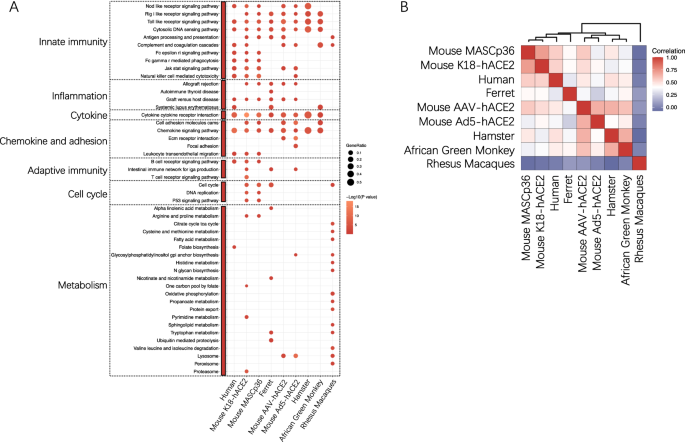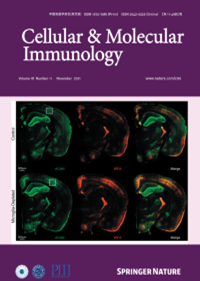动物模型中的 SARS-CoV-2 免疫力。
IF 21.8
1区 医学
Q1 IMMUNOLOGY
引用次数: 0
摘要
由严重急性呼吸系统综合症冠状病毒 2(SARS-CoV-2)引起的 COVID-19 大流行因其传播性而成为世界性的健康危机。SARS-CoV-2 感染会导致严重的呼吸道疾病,并可能给患者带来严重的并发症。这些并发症包括咳嗽、呼吸窘迫、发热、感染性休克、急性呼吸窘迫综合征(ARDS)甚至多器官衰竭等症状。动物模型是研究致病机制、免疫反应、免疫逃逸机制、抗病毒药物开发和 SARS-CoV-2 疫苗的重要工具。目前,已开发出多种感染 SARS-CoV-2 的动物模型,如非人灵长类动物(NHPs)、雪貂、仓鼠和许多不同的小鼠模型。每种模型都具有不同的特点和应用。在这篇综述中,我们阐明了患者感染 SARS-CoV-2 所引起的免疫反应,并概述了主要用于 SARS-CoV-2 感染的各种动物模型的特点,以及这些模型的相应免疫反应和应用。对不同动物模型肺部转录组变化的比较分析表明,K18-hACE2和小鼠适应病毒小鼠模型与COVID-19死亡患者的相似度最高。最后,我们强调了目前相关研究在动物模型研究与临床研究之间存在的差距,强调了有待进一步澄清的科学问题。本文章由计算机程序翻译,如有差异,请以英文原文为准。


SARS-CoV-2 immunity in animal models
The COVID-19 pandemic, which was caused by severe acute respiratory syndrome coronavirus 2 (SARS-CoV-2), has become a worldwide health crisis due to its transmissibility. SARS-CoV-2 infection results in severe respiratory illness and can lead to significant complications in affected individuals. These complications encompass symptoms such as coughing, respiratory distress, fever, infectious shock, acute respiratory distress syndrome (ARDS), and even multiple-organ failure. Animal models serve as crucial tools for investigating pathogenic mechanisms, immune responses, immune escape mechanisms, antiviral drug development, and vaccines against SARS-CoV-2. Currently, various animal models for SARS-CoV-2 infection, such as nonhuman primates (NHPs), ferrets, hamsters, and many different mouse models, have been developed. Each model possesses distinctive features and applications. In this review, we elucidate the immune response elicited by SARS-CoV-2 infection in patients and provide an overview of the characteristics of various animal models mainly used for SARS-CoV-2 infection, as well as the corresponding immune responses and applications of these models. A comparative analysis of transcriptomic alterations in the lungs from different animal models revealed that the K18-hACE2 and mouse-adapted virus mouse models exhibited the highest similarity with the deceased COVID-19 patients. Finally, we highlighted the current gaps in related research between animal model studies and clinical investigations, underscoring lingering scientific questions that demand further clarification.
求助全文
通过发布文献求助,成功后即可免费获取论文全文。
去求助
来源期刊
CiteScore
31.20
自引率
1.20%
发文量
903
审稿时长
1 months
期刊介绍:
Cellular & Molecular Immunology, a monthly journal from the Chinese Society of Immunology and the University of Science and Technology of China, serves as a comprehensive platform covering both basic immunology research and clinical applications. The journal publishes a variety of article types, including Articles, Review Articles, Mini Reviews, and Short Communications, focusing on diverse aspects of cellular and molecular immunology.

 求助内容:
求助内容: 应助结果提醒方式:
应助结果提醒方式:


